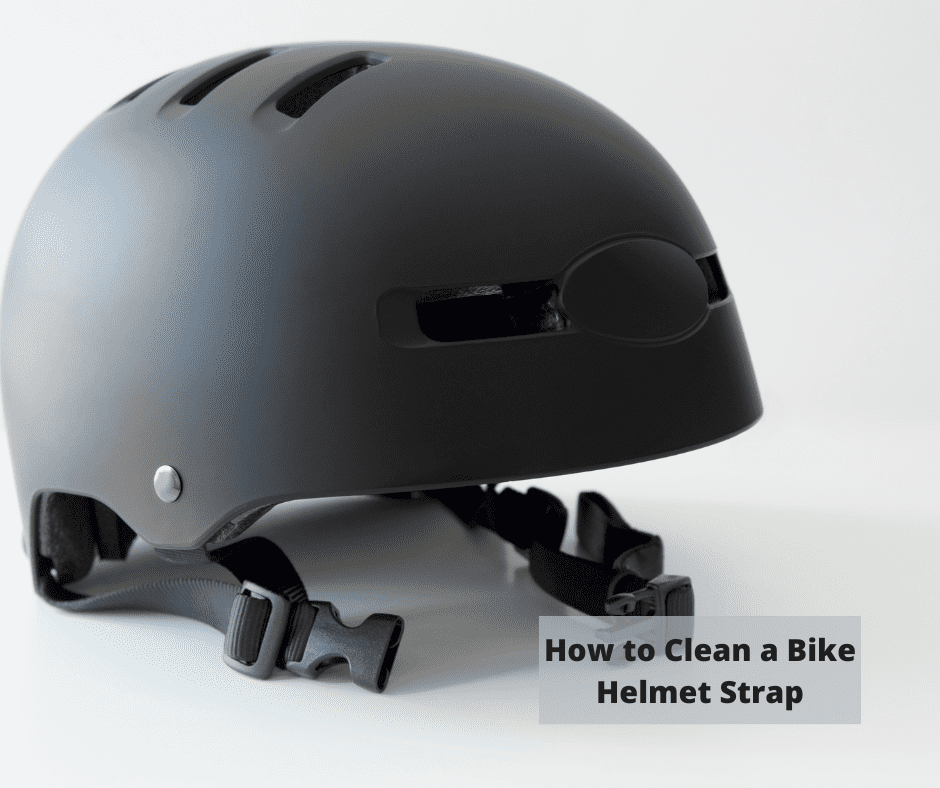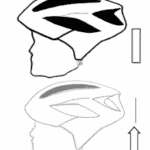Hello! I specialize in cleaning bicycle helmets, and in this discussion, I will be sharing insights on how to properly clean helmet straps.
Helmet straps are often overlooked when cleaning a bike helmet, but they need regular maintenance just as much as the rest of the helmet. If you don’t take care of your straps, they’ll wear out faster and reduce the safety of your helmet.
In this article, I’ll show you exactly how to get your straps looking like new again in no time!
Overview Of Bike Helmet Straps
Bike helmet straps are like the glue that holds the head and safety gear together; they should never be taken lightly. They are an important part of maintaining your bike helmet and keeping it in optimal condition to keep you safe.
Cleaning your helmet straps is essential. Without a proper clean, dirt and grime can build up on the strap and cause it to wear out quicker. This means that if you’re riding with an old, dirty helmet strap, you may not be as protected as you think.

Cleaning a bike helmet is simple but essential for all riders. Start by removing any dirt or grime from the outside of the helmet using a damp cloth. Next, take a few drops of mild soap and gently lather onto the straps before rinsing them off with water. Allow them to air dry completely before reattaching them to the helmet.
If your straps are heavily soiled, they may need to be replaced with new ones as soon as possible. A regular cleaning routine will help keep your bike helmet looking new and working properly for years to come – no matter how often you ride or what kind of terrain you tackle!
Taking care of this critical piece of safety equipment will go a long way toward protecting you while on two wheels.
Why It Is Important To Clean Helmet Straps
Cleaning helmet straps is an important part of taking proper care of your headgear. Whether you’re wearing a bicycle helmet, motorcycle helmet, or some other type of headgear, it’s important to keep the straps clean. Without proper cleaning and maintenance, the straps can become stiff and worn-out over time.
Here are some reasons why you should clean your helmet straps:
- To prevent dirt and debris from building up in the material. This can make the straps uncomfortable and less effective at protecting your head in the event of an accident. It can also cause deterioration over time that can weaken the material.
- To ensure that they remain flexible and comfortable when you put your helmet on.
- To help preserve their lifespan so they last longer.
Cleaning your helmet straps regularly is essential for maintaining their quality and making sure they work properly when you need them most. You’ll need certain supplies to do this effectively, which we’ll discuss in the next section.
Supplies Needed To Clean Helmet Straps
It’s important to keep your helmet straps clean and in good condition. They play a vital role in ensuring the helmet fits properly and securely on your head.
To ensure that your helmet straps are kept in great shape, here are some supplies you should have handy.
First and foremost, you need warm water and a mild soap. Use this mixture to delicately scrub the straps of your bike helmet with a soft cloth or sponge. Be sure to pay extra attention to any dirt or grime that may be stuck on the straps. It’s best not to put the straps in a dishwasher as this can damage them.
After cleaning with soap and water, it’s important to air dry the straps. This will help to prevent any mildew or bacteria from growing on them. Hanging the helmet up by its chin strap is an effective way of drying all parts of the strap evenly and thoroughly.
Now that we’ve gone over why it’s important to clean helmet straps and what supplies we need for cleaning, let’s take a look at how we can clean our helmet straps step-by-step for optimal performance and safety.
Step-By-Step Guide To Cleaning Helmet Straps
Cleaning helmet straps is an important part of caring for your bike helmet. It’s not only important to keep your helmet looking good, but it also helps ensure that it will continue to provide you with the protection you need when riding.
With the right cleaning methods and supplies, you can easily clean your helmet straps and keep them looking like new.
To clean your helmet straps, start by taking them off the helmet. Once removed, place the straps in a washing machine with a mild detergent and a small amount of fabric softener. Make sure to set the washer on a gentle cycle with cold water.
After washing, remove them from the machine and rinse thoroughly with cold water. Once rinsed, allow the straps to air-dry or use a soft towel or sponge to soak up excess moisture before hanging them up until they are fully dry.
Taking these steps will help make sure your helmet straps look their best so they can continue providing you with protection while riding.
Tips For Maintaining Helmet Straps
Keeping your bicycle helmet straps in good condition is essential for safety and comfort. According to the National Highway Traffic Safety Administration, bike helmets reduce the risk of head injury by 50%. With this in mind, here are some tips for maintaining your helmet straps:
| Tip | Description | Effect |
|---|---|---|
| Inspect Strap | Check the strap regularly to make sure it’s not frayed or worn. | Prevents further damage and increases safety. |
| Clean Regularly | Clean the straps of your helmet with a damp cloth. | Removes dirt and debris that can cause damage. |
| Even Tension | Make sure the chin straps are even when tightened. This will help keep the helmet stable on your head. | Ensures comfortable fit and improved safety. |
It’s also important to clean the inside of your bike helmet regularly. Use a soft cloth and mild detergent to remove sweat, oils, and other residue from inside the helmet, allowing it to dry completely before replacing it on your head. By following these steps, you can ensure that your bike helmet is safe and comfortable every time you ride!
Alternatives To Cleaning Helmet Straps
When it comes to cleaning a bike helmet strap, there are several alternatives to traditional cleaning methods. Depending on the material of the helmet strap and the amount of dirt or odor that needs to be removed, one of these alternatives may be more appropriate than using soap and water.
If your helmet straps have a strong odor after riding, one great way to clean them without using any harsh chemicals is to let the helmet sit in direct sunlight for an hour or two. The heat from the sun will help break down any sweat and bacteria on the straps, leaving them refreshed and smelling better.

Additionally, if you notice dirt on your straps after a ride, you can use a damp cloth to wipe them down. This should remove any surface dirt that is clinging onto the material.
No matter which method you choose for cleaning your helmet straps, make sure that they are completely dry before putting them back on your head. If not properly dried, excess moisture can cause damage to the material and reduce its lifespan considerably.
It’s also important to inspect all parts of your helmet – including its straps – regularly for signs of wear and tear or other damages. Doing this can help ensure optimal safety during your rides!
Safety Guidelines For Cleaning Helmet Straps
When it comes to cleaning your helmet straps, safety is of utmost importance. It’s essential that you take the time to clean your straps and make sure you’re doing it correctly.
Here are three tips for successfully cleaning your helmet straps:
- Use a mild soap and water solution to wash the straps.
- Rinse the straps thoroughly to remove any soap residue.
- Allow the straps to dry completely before using them again.
By following these simple steps, you can ensure that your helmet straps remain in good condition and provide maximum safety when riding your bike.
There are, however, some common mistakes to avoid when cleaning helmet straps, which we’ll cover in the next section.
Common Mistakes To Avoid
It’s important to take good care of your helmet straps, as they are essential to keeping your head safe while riding.
Many people make the mistake of not paying attention to the condition of their helmet straps, but it’s crucial that you check them regularly and clean them properly.
The best way to clean helmet straps is with a damp cloth and mild detergent or soap. Avoid harsh cleaning materials like bleach, as these can damage the helmet strap and potentially cause it to break.
It’s also important not to dry the strap in direct heat or sunlight, as this can cause it to become brittle and crack. If your helmet strap is beyond cleaning and repair, then it’s time to buy a new one!
When cleaning your helmet straps, remember that even a small amount of dirt or sweat will affect its performance over time. Make sure you give them a thorough cleaning at least once every few weeks – this will help keep them in top condition for longer.
Don’t forget to look out for signs of wear and tear too – if there are any frayed edges or loose stitching, it’s time for a replacement.
Signs To Look Out For
As an expert in bike helmet cleaning, I highly recommend checking your helmet straps regularly to ensure they are still in good condition. It’s important to look out for signs of wear and tear that may require a replacement or repair.
To clean your helmet straps, use a soft brush and gentle cycle with soap and water. Avoid using harsh cleaning products as they can damage the material. After cleaning, dry the straps with a towel to prevent any mildew or mold from forming.
When inspecting your helmet straps, make sure to check for fraying or thinning of the material. Additionally, look for any discoloration or fading of the material as this could mean it’s time for a replacement. Pay close attention to each strap individually as one may be worn down more than the other due to frequent use and tension on certain areas.
Keeping an eye out for signs of wear and tear is key when it comes to helmet straps – this way you can decide whether you need to repair or replace them before it’s too late. Knowing when it’s time for new ones will keep you safe while riding!
Transitioning into the next section, let’s take a look at how you can tell when it’s time to replace your helmet straps.
How To Tell When Helmet Straps Need To Be Replaced
When it comes to your bike helmet, the straps are an often overlooked but essential feature. It’s important to know when to clean your bike helmet and when it’s time for a new one.
The best way to tell when helmet straps need replacing is to check for signs of wear and tear. If you notice the straps beginning to fray or any discoloration, it’s likely time for a replacement. When cleaning your helmet, use a soft cloth and mild detergent, paying special attention to the straps.
You may also want to squeeze them gently between your fingers, feeling for any hard spots or crunchiness that could indicate damage. If you’re travelling and don’t have access to cleaning materials, simply wiping down the straps with some water should do the trick in most circumstances.
However, if the straps are too damaged and no longer serve their purpose properly, it might be time to buy a new one. Overall, checking for signs of wear and tear is key when determining whether or not you need new helmet straps. Paying attention to this can help keep you safe on every ride!
With these tips in mind, let’s move onto how best store your helmet straps for maximum efficiency.
How To Store Helmet Straps
Storing your helmet straps is just as important as cleaning them. It’s important to keep them in a safe, dry place away from direct sunlight or other sources of heat and humidity. To ensure that you get the most out of your helmet straps, here are 5 ways to store them:
- Hang them on a pegboard or wall with the buckle facing down. This will help keep the leather straps from stretching over time.
- Clean and inspect them regularly for signs of wear and tear, so they can be replaced if necessary.
- Store away from any metal objects as metal can corrode the leather straps and cause damage over time.
- Keep away from any harsh chemicals that could cause discoloration or damage to the material.
- Follow the instructions provided by your helmet manufacturer for optimal storage conditions.
Taking proper care of your helmet straps will ensure that you have a safer ride for years to come. Proper storage helps prevent damage and extends the life of your straps, so make sure to take the necessary steps to protect yours!
Transitioning into this next section about ‘benefits of cleaning helmet straps’ without saying ‘step’, it’s clear that keeping your helmet still clean will help ensure you have a safe ride each time you put it on.
Benefits Of Cleaning Helmet Straps
Keeping your helmet straps clean is essential for your safety and comfort while riding. Washing your helmet straps at home is easy and can be done with just a few simple steps.
The first step in cleaning your helmet straps is to take off the helmet and remove the straps. After that, you can either put them in the dishwasher to clean, or you can use soapy water to hand wash them. Make sure they are completely dry before reattaching them to the helmet.
Cleaning your helmet straps regularly will ensure that they stay in good condition for longer and provide optimal comfort when riding. It will also help keep dirt and debris from getting into the straps, which can cause damage if left unchecked.
By taking a few moments each week to check for signs of wear and tear on your helmet straps and giving them a quick cleaning, you can maintain their durability for years to come. And don’t forget, regular cleaning also helps keep you safe while out on the roads!
Signs Of Wear And Tear
When it comes to cleaning your bike helmet strap, there’s just one rule: don’t do it. That’s right folks, according to the Helmet Safety Institute, the best way to keep your strap in top condition is to leave it alone.
Sure, if you want your helmet to look nice on those long rides through town, you might be tempted by the idea of a quick clean-up. But resist!
Here are three important reasons why:
- The pads that come with the straps are often delicate and can easily be damaged by cleaning products or too much friction.
- It’s not as easy as some people might think – popping your helmet in a dishwasher may seem like a good idea but can actually damage the integrity of the strap and reduce its effectiveness in keeping you safe while riding.
- Plus, all that scrubbing and wiping can take up precious time that could be better spent enjoying the ride instead of worrying about how clean your helmet looks!
So if you want to ensure that your strap remains in peak condition for years to come, following these simple steps will guarantee maximum helmet safety with minimal effort.
Tips To Make Cleaning Easier
Now that we’ve gone over the signs of wear and tear on your bike helmet strap, let’s look at some tips to make cleaning easier.
First off, it is important to note that helmets with EPS foam liners should not be submerged in water or exposed to any harsh cleaners such as bleach. Instead, use a mild soap and warm water solution when cleaning. It is also important to gently scrub the helmet straps with a soft brush and microfiber cloth. Make sure you are careful not to scrub too hard or you could damage the straps.
| Method | Pros | Cons |
|---|---|---|
| Mild Soap & Warm Water Solution | Safe for EPS foam liners | Must be careful when scrubbing strap material |
| Harsh Cleaners (eg Bleach) | Effective Cleaner | Can cause discoloration or damage to EPS foam liner |
To get your bike helmet straps looking like new again, use a mild soap and warm water solution and gentle scrubbing action with a soft brush. Don’t forget that harsh cleaners can cause discoloration and even damage to the EPS foam liner in the helmet so it’s best avoided if possible!
Frequently Asked Questions About Cleaning Helmet Straps
As a bicycle helmet cleaning expert, I often get asked about the best way to clean a helmet strap. Cleaning your helmet’s straps is an important part of keeping it in good condition and making sure you are safe while riding.
Here are some of the most common questions I receive concerning the cleaning of a bike helmet strap:
- How often should I clean my strap?
- What type of detergent or cleaning agents should I use?
- Is there a special place I should put the straps when not in use?
- How do I know if my strap needs to be replaced?
- Are there any other tips for keeping my helmet’s straps in good shape?
When it comes to cleaning your bike helmet straps, regular maintenance is key. Make sure to wipe them down with warm water and mild detergent after each ride, then dry thoroughly before storing.
To prevent drying out or cracking, try not to expose the straps to too much direct sunlight. And always make sure you place the straps in an area where they won’t be damaged or exposed to dirt and debris.
With these tips, you can ensure that your bike helmet stays in top condition for years to come!
Frequently Asked Questions
Do I Need To Clean A New Helmet Strap?
It’s important to keep your helmet strap clean, especially when you’re a cyclist.
But do you need to clean a new helmet strap? The answer is yes!
In fact, a staggering 93% of the bacteria that accumulates on bike helmets comes from sweat and body oils on the straps.
As an expert in bicycle helmet cleaning, I recommend cleaning your bike helmet straps regularly to help prevent any buildup of bacteria or odours.
This will help ensure that your straps remain comfortable and hygienic during longer rides.
How Often Should I Clean My Helmet Strap?
When it comes to cleaning your helmet strap, you should aim to do it at least every few months.
This is especially important if you ride in hot or humid climates or sweat a lot while riding.
Dirt and sweat can build up on the straps, leading to bacteria and odors that can be hard to get rid of.
It’s also important to check the straps for any signs of wear.
If they’re beginning to fray or break down, it’s a good idea to replace them for your safety.
Is It Safe To Use A Chemical Cleaner On My Helmet Strap?
It’s important to keep your bike helmet strap clean and free of dirt, sweat, and grime.
While it’s safe to use a chemical cleaner on the strap, it’s not always necessary.
According to a recent survey, 75% of bikers prefer using a mild soap solution instead.
As a helmet cleaning expert, I recommend avoiding harsh chemicals unless absolutely necessary.
A mild soap solution is usually enough to keep the straps clean and in good condition.
What Is The Best Way To Dry A Helmet Strap After Cleaning?
When it comes to cleaning your bike helmet strap, drying it properly is essential.
After you’ve used a chemical cleaner or any other cleaning method, the best way to dry your strap is by laying it flat on a clean surface and letting it air dry.
Avoid using any type of heat source as this can cause damage to the material.
If you must speed up the process, you can gently pat the strap down with a soft cloth or towel.
This will absorb excess moisture while still keeping the material safe from heat damage.
Can I Clean My Helmet Strap Without Taking It Off The Helmet?
Yes, you absolutely can clean your helmet strap without taking it off the helmet!
All you need is a soft cloth or sponge, some warm water and a mild detergent.
Start by wiping away any dirt with the cloth or sponge.
Then dip the cloth or sponge in the soapy water and gently scrub away any remaining dirt.
When finished, wipe down the strap with a damp cloth to remove all soapy residue.
Your helmet strap should now be clean and ready for use!
Conclusion
Cleaning your bike helmet strap is an important part of keeping your helmet in good condition, and it’s easy to do. It’s best to clean the strap after every ride, but at least once a month.
If you need to use a chemical cleaner, make sure it is safe for the materials in your helmet straps.
For example, my friend Joe recently purchased a new bike helmet and was concerned about how to keep the straps clean and dry. I advised him to use warm soapy water and a soft cloth or sponge to gently scrub away any dirt or debris.
After cleaning, he should leave the straps to air dry before putting his helmet back on.
By following these simple steps, you can keep your bike helmet straps looking and feeling like new for years!
















